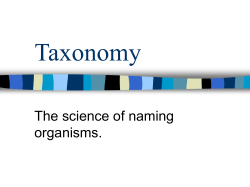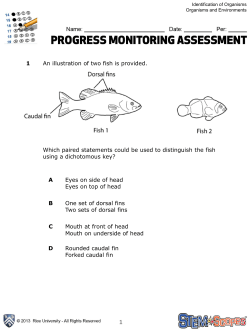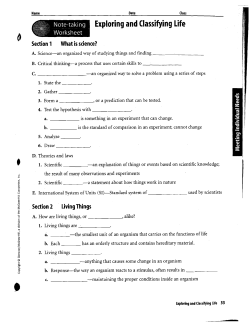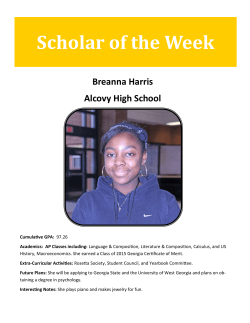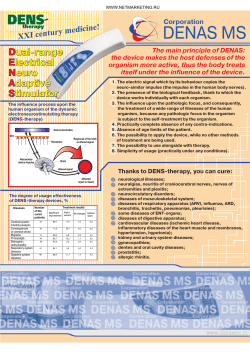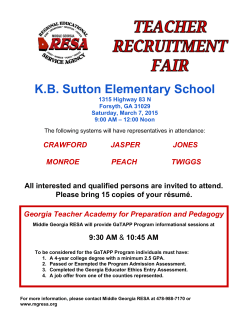
Crazy Classification
Crazy Classification Lesson Focus: Classification and Dichotomous Keys Learning Objectives: • • • • Students will learn what a dichotomous key is. Students will explore how classification is used to make identifying an organism easier. Students will create their own dichotomous key. Students will classify animals according to their similarities and differences. Enduring Understandings for the Lesson: • • • Classification is a system to put things into orderly groups based on similar characteristics. Taxonomists today use an eight-level system of classification to hypothesize how closely related living things are. The more characteristics organisms share, the more closely related they are. Georgia Performance Standards Addressed: S7L1: Students will investigate the diversity of living organisms and how they can be compared scientifically. a. Demonstrate the process for the development of a dichotomous key. b. Classify organisms based on physical characteristics using a dichotomous key of the six kingdoms (archaebacteria, eubacteria, protists, fungi, plants, and animals). S7CS6: Students will communicate scientific ideas and activities clearly. c. Organize scientific information using appropriate simple tables, charts, graphs and identify relationships they reveal. Grade Level: 7th Materials: • • • • Classification Power Point presentation Computer access with projector or Computer lab Grapes, banana, orange, apple, peach, and plum Baggies filled with buttons of various shapes, sizes, and colors (one per 5 students) • • • • • Pen/pencil, notebook paper Outside access to school grounds, preferably with a water source nearby Containers for holding collected samples Containers with plastic bugs of various species (optional) Microscopes Time Needed: 2 class periods with homework assignments Background Information: Classification was created to place animals into categories based on similar characteristics. We commonly classify things based on their usefulness, but biologists classify living things to answer many important questions, like number of species, characteristics of species, and relationships between species. Taxonomy is the science of describing, classifying, and naming living things. Classifying an organism allows scientists to give each organism its own scientific name and categorize them in an organized system. Dichotomous keys were created by using pairs of statements to eventually distinguish and therefore identify one single species of an organism from another. Classification is the tool that scientists use to identify organisms on Earth; however, it is still a growing system as newly-discovered organisms are continuously being found and added to this flexible system. From the days of Aristotle, living things have always been naturally grouped and these groups have changed from time to time throughout history. For most of the latter half of the twentieth century science recognized five kingdoms, grouping single celled organism with no true nucleus into one group. In the late 70’s, these single celled prokaryotes were split into the larger group Eubacteria and the much smaller and specialized Archaebacteria. In the early 90’s, a new view of kingdoms became popular by simply placing these cell based groupings into “domains” of Eubacteria, Archaebacteria, and Eukarya, and then having the four eukaryotic kingdoms be under the same domain. This allowed for a simple yet effective distinction at a cellular level. Taxonomy is and always will be the study of how living things are grouped together to understand the extreme biodiversity that life has to offer. Understanding how living things are different leads naturally to understanding how they are similar at the same time. Learning Procedure: 1. (Day 1): Have a bowl of fruit filled with grapes, a banana, an orange, an apple, a peach, and a plum in the front of the room. Hold each item up, asking students what they think the items have in common? Write their ideas on the board as they brainstorm. 2. Show students the Power Point entitled CLASSIFICATION. Have them take notes on each slide until you reach the one titled Dichotomous Key. Lead students 3. 4. 5. 6. 7. through each stage of the dichotomous key as you hold up each piece of fruit fitting that description. (For example: Step 1: Fruits occur singly or Fruits occur in clusters of two or more…go to the next step until students have been able to identify each piece of fruit in the bowl). Place students into small groups and click to the next slide called “practice using dichotomous keys”. Clearing their desks of everything except for paper and something to write with, give each group a baggie of buttons in various shapes, sizes, and colors. Let students create their own dichotomous keys by placing the buttons into categories based on similarities. (You may want to leave the fruit key on the screen as a resource.) Have the students share their keys with the rest of their class, comparing their group findings to others. Have students go home and pick a messy area in their homes, yards, etc., to organize. For example, their closet, a junk drawer, their video game collection, music collection, etc. Let the students create a dichotomous key in which they place the items into categories based on similar characteristics. (Day 2): The Kingdoms: introduce students to the 6 kingdoms using the second part of the PowerPoint presentation and then practice identifying living things in different kingdoms. Take students outside on an excursion of their school grounds. Hopefully, you have access to a stream or body of water. Have students identify at least two species from each kingdom (use their imaginations with the bacteria and protists), View water samples under the microscope. Have the students’ journal their findings including descriptions, drawings, and characteristics of their samples that place them in a specific kingdom. Evaluation: Provide students with a container of plastic bugs of various species. Have them create a dichotomous key putting the bugs into categories based on their similarities. Extensions: Have students research an organism from each of the six kingdoms, presenting the research to the class in presentation. Ask students to access the image section located on the Gray’s Reef and/or Georgia Aquarium websites and select ten fish and ten invertebrates. Ask them to create their own dichotomous key based solely on the physical characteristics of the organisms they can see in the images. They can then check for accuracy by comparing their key to an actual scientific key for marine fish and invertebrates. Resources: Classification: The three domain system o http://student.ccbcmd.edu/courses/bio141/lecguide/unit1/3domain/3dom ain.html o An introduction to another approach to the six Kingdoms focusing on the difference between eukaryotes, eubacteria, and archaebacteria. How plants and animals differ o http://www.virted.org/Plants/PlantsDiffer.html o A focused website on the differences between plants and animals Aquatic Plants o http://www.aquatic.uoguelph.ca/plants/index.htm o A look at forms of aquatic life and how they differ Reef Fish o http://www.reef.org/ o http://graysreef.noaa.gov/ o http://www.georgiaaquarium.org/ Lesson developed by: Erin Porter, Banks County Middle School, Homer, GA and Mihkel Allpere, Georgia Aquarium This activity is a product of the Rivers to Reef Teacher Workshop sponsored by the Georgia Aquarium and Gray’s Reef National Marine Sanctuary that the author participated in. For more information about this workshop, Georgia Aquarium, or NOAA Gray’s Reef National Marine Sanctuary, please visit our websites at www.georgiaaquarium.org or http://graysreef.noaa.gov/
© Copyright 2025

